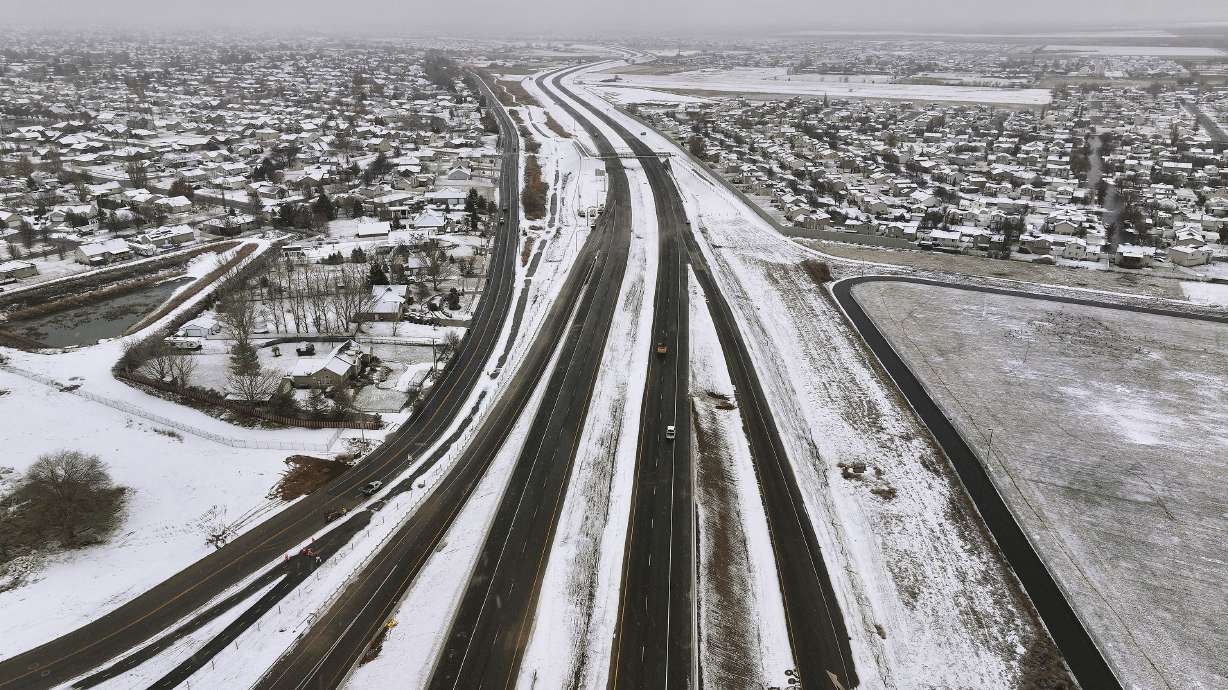Estimated read time: 5-6 minutes
This archived news story is available only for your personal, non-commercial use. Information in the story may be outdated or superseded by additional information. Reading or replaying the story in its archived form does not constitute a republication of the story.
WEST POINT — With the completion of the first leg of the West Davis Highway, many are welcoming the new roadway, which will help ease congestion on I-15 as growth boosts auto and truck traffic.
Roads officials estimate the new 16-mile corridor, a divided, four-lane roadway connecting Farmington and West Point, will also reduce use of smaller streets and arterials in the neighborhoods around it, cutting congestion in the area by 30%. Beyond that, Utah Department of Transportation spokesman Mitch Shaw, speaking Friday from a work area beside the new roadway in West Point, noted all the new subdivisions taking shape along the West Davis Highway corridor, underscoring the growth that spurred the project.
"You can see them everywhere and it's going to continue to happen," he said. UDOT officials, area leaders and the media gathered Friday for a test ride along the new road section.
Still, with the roadway to open to the public at 11:30 a.m. on Saturday after a 10 a.m. ceremony, not everyone is thrilled.
Lynn de Freitas, executive director of Friends of the Great Salt Lake, an environmental group, says the cars and eventual development accompanying the opening of the roadway will have a big impact. The quality of water in the Great Salt Lake and the wetlands near the roadway will likely take a hit, exhaust will probably impact the air and anticipated development will whittle away at the natural habitat of the critters in the area.

"It's just slightly disheartening," she said. "The more that we build roads and the less that we provide alternative forms of transportation, the more we create problems that won't go away."
The $750 million, 16-mile section traverses the west side of Davis County, east of the bed of the Great Salt Lake, connecting Farmington, Kaysville, Layton, Syracuse and West Point.
At its southern endpoint near Glovers Lane, the new road connects to Legacy Parkway and I-15 while in the years and decades to come it's to be extended northward beyond West Point into Weber County. Parallel to that project, I-15 was widened between Roy and Layton as part of a project completed in 2022; U.S. 89 got an extra lane each way between Farmington and South Weber; and UDOT officials are mulling expansion of I-15 south of Farmington to Salt Lake City.
"Does this ever stop?" de Freitas said.
Roger Borgenicht, co-founder and co-chairman of Utahns for Better Transportation, suspects the West Davis Highway will encourage auto use at the expense of public transit and other alternative forms of transportation. "It will create more auto dependence and I think we've got to start shifting away from that," Borgenicht said.
Moreover, he foresees accelerated development in the area, even if it is already growing. "Freeways and highways at their intersections inevitably bring commercial and other development," he said.
Borgenicht had pressed UDOT officials to consider an alternative plan years ago that would have precluded West Davis Highway development, ultimately to no avail. The "Shared Solution," as the plan was dubbed, called for development of the grid of existing roadways in the impacted area between Farmington and West Point. New bus-only lanes would have been added to some roads, thereby making transit to FrontRunner stations easier, encouraging public transit use and theoretically eliminating the need for the West Davis Highway.
"The idea was not to do the highway. The idea was to improve the arterial grid and the local transit and local bikeways. That would give people a viable choice," Borgenicht said. With continued population growth, quality of life can only be maintained by developing transportation choices aside from private autos, he said, arguing that "we can't build our way out of congestion."
Shaw, the UDOT spokesman, said the agency was mindful of environmental and other concerns in designing the roadway corridor and determining its location.
"We agree on a lot of things," he said, alluding to advocates like Borgenicht and de Freitas. Road officials spent seven years on the West Davis Highway design process, getting feedback from a broad range of people and groups.

The input "included information on wetlands and the natural habitat along the shore lands of the Great Salt Lake," Shaw said. Roads officials "coordinated closely with the U.S. Army Corps of Engineers, the U.S. Fish and Wildlife Service, the Environmental Protection Agency, the Utah Division of Wildlife Resources and the Nature Conservancy to minimize environmental impacts and to protect water quality for wildlife in the area."
UDOT officials even weighed the option of not building the West Davis Corridor, Shaw said, but ultimately discarded the possibility. Doing nothing would have eventually boosted traffic on I-15 and other area streets to intolerable levels. "We do have to strike a balance between providing infrastructure for all the growth we're seeing," he said.
That said, UDOT increasingly incorporates alternative modes of transportation into its plans. A path for bicycles and pedestrians accompanies the West Davis Highway. "It's become more and more of a focus of UDOT, to look for ways to allow for changes in transportation. We want to see people walking. We want to see people biking," he said.
Either way, Borgenicht foresees big change in the west Davis County area, not necessarily for the good. The character of the area "will change dramatically with this new highway," he said.









